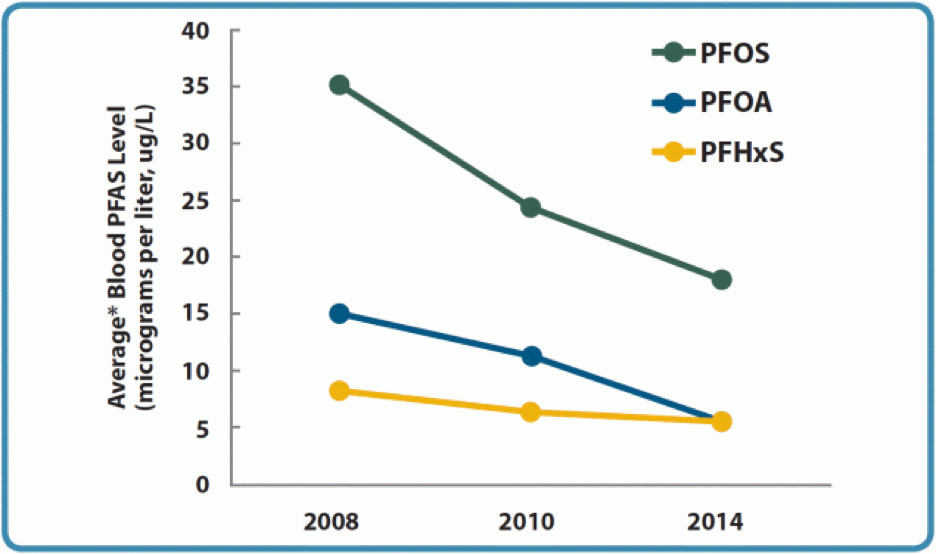What are the PFAS Health Effects?

What are the PFAS Health Effects?
Increasingly, Connecticut residents are learning more about PFAS. As governmental organizations, such as the US Environmental Protection Agency (EPA) and many colleges are studying PFAS, the results seemingly indicate many negative health effects. So, as the studies and findings roll in, it makes sense to look at PFAS health effects.
First, what are PFAS?
The EPA describes PFAS as “man-made chemicals that include PFOA, PFOS, GenX, and many other chemicals.” Along those lines, most studies on PFAS include the main chemicals outlined by the EPA.
- PFOA (perfluorooctanoic acid)
- PFOS (perfluorooctanesulfonic acid)
- PFHxS (perfluorohexane sulfonic acid)
- PFNA (perfluorononanoic acid)
Although the scientific information is helpful, many of us still don’t know exactly what PFAS are and why they may negatively impact our health.
In layman’s terms, PFAS are chemicals created by manufacturing companies that offer unique resistance to petroleum, heat and water. As a result, many water resistant, oil resistant and fire resistant consumer products contain PFAS! For example, the following products frequently contain PFAS:
- Cookware
- Food Packaging
- Stain Repellent Fabric
- Water Repellent Fabric
- Polishes
- Waxes
- Paints
- Cleaning Products
PFAS date back to the 1940s. However, since research has started and early results indicated PFAS yield potentially negative health effects, manufacturers have stopped using them. But, as the Agency for Toxic Substances and Disease Registry1 (ATSDR) noted, manufacturers develop new chemicals similar to PFAS, which means more studies are required to determine their impact.
“New kinds of PFAS are being developed. Some of these may have properties similar to the existing PFAS, and some may be less persistent in the environment. There are very few scientific studies on new PFAS, so more research is necessary to discover whether they may be a health concern.”
Reducing PFAS Exposure
Due to their industry-wide adoption within the manufacturing industry, PFAS exposure occurs from using products, but also from your local environment. For example, according to the CDC2, PFAS exposure potentially occurs from contaminated water and soil by:
- Consuming fish caught from contaminated water.
- Consuming food grown in contaminated soil.
- Drinking contaminated municipal water.
- Drinking contaminated private well water.
As scientists and ultimately consumers learn more, many people want to learn about reducing their PFAS exposure. For example, testing your water to understand if you have any contamination always offers a great starting point. If your home contains PFAS, then the easiest way to reduce PFAS exposure is through bottled water specifically treated and tested for PFAS. Fortunately, most popular water bottle brands include this in their testing and treatment of water. Importantly, if you know your water contains PFAS, DO NOT boil your water! This does not do anything to remove the chemicals, but concentrates them. Finally, water treatment and filtration processes that utilize activated carbon and reverse osmosis effectively eliminate PFAS from your home water sources.
Lasting PFAS Health Effects
One of the most important things uncovered by researchers is PFAS accumulate over time. What does this mean? PFAS do not break down in the body. As a result, as people are exposed to the chemicals, then the more PFAS remain in their body! For example, the EPA established lifetime exposure guidelines from drinking water to 70 parts per trillion3. However, in Michigan4, which experienced significant clean water issues, a recent study was conducted that suggests lifetime PFAS exposure from drinking water should be lower than the EPA guidelines.
PFAS health effects researchers observed in people with PFAS exposure include:
- Increased cholesterol levels
- Reproductive and/or developmental issues (including low infant birth weights)
- Liver and kidney problems
- Lowered immune system
- Thyroid hormone disruption (exposure to PFOS)
- Cancer (exposure to PFOA)
Additionally, from national news organizations to various state governments and universities, researchers continue conducting studies about the lasting health effect of PFAS exposure. Generally, these different studies continue to come to the same conclusion that exposure to PFAS leave negative health effects.
-
Potential PFAS Exposure to Children
The amount of information that remains unknown about PFAS is perhaps the most uncomfortable thing about the chemical. For example, the Rhode Island Department of Health5 shared PFAS information and included important caveats for pregnant women.
“The biggest concerns are for women who are pregnant or likely to become pregnant and children. We cannot accurately predict what health effects individuals may experience if they are exposed to PFAS. Studies on laboratory animals, supported by some evidence from studies of humans indicate that exposure to specific PFAS over certain levels could result in adverse health effects.”
The report includes a potential list of health issues for pregnant women and their children due to PFAS exposure (and the related chemicals), which include:
- developmental effects in infants.
- lower a woman’s chance of getting pregnant.
- increase a woman’s blood pressure during pregnancy.
- lower infant birth weights.
- interfere with the body’s natural hormones.
- increase cholesterol levels.
- affect the immune system.
- increase the risk of cancer.
Related, the Rhode Island report notes the potential PFAS exposure to babies through breastfeeding or through formula made with water that contains PFAS. Plus, the report highlights that younger children, such as babies and toddlers, increase their possible exposure from carpets and cleaning products as they spend lots of time crawling and lying on the floor.
Additionally, a professor in the Department of Environmental Health at the University of Cincinnati shared concerns about the lasting impact of PFAS6 on children.
“I think that people should be concerned about the amount of PFOA and PFOS that is in our environment. These are chemicals with long half-lives…Exposure in utero may have the greatest effect on developing children…and effects may last into adulthood.”
-
Limiting PFAS Exposure
Although more testing and studies will help scientists understand the lasting PFAS health effects, the Harvard University School of Public Health7 did release a report noting the known health effects, such as:
- cancer.
- liver damage.
- decreased fertility.
- increased risk of asthma.
- increased risk of thyroid disease.
Elsie Sunderland, associate professor of environmental science and engineering in the Department of Environmental Health at Harvard T.H. Chan School of Public Health, contributed to the general findings and noted:
“that scientists are just beginning to understand the effects of the more than 4,000 different types of PFASs and the chemical industry routinely uses new compounds to replace old ones. People call it chemical whack-a-mole.”
As scientists and people learn more, fortunately, concerned citizens can take actions now to reduce their cumulative levels.
For example, Public Health officials in Madison, Wisconsin, provided information to their constituents that aligns with other recommendations from Harvard, Rhode Island and the CDC. In Madison, WI, they recommend filtered water, both granular activated carbon and reverse osmosis filters.
“When amounts of PFAS in water are higher than the Wisconsin Recommended Groundwater Enforcement Standard level of 20 parts per trillion, we recommend the use of bottled water or a filtration system certified to reduce PFOS and PFOA for drinking, cooking, making baby formula or food, washing fruits or vegetables, brushing teeth, or feeding pets.”
Additionally, preliminary findings from ATSDR8 in conjunction with the Minnesota Department of Health showed the impact of water filtration systems on PFAS levels in the bloodstream. The study occurred in the mid-2000s following the installation of a water filtration system in 2006. The sampling of residents occurred in 2008, 2010 and 2014. The study determined that PFAS (and related chemicals) decreased in long-term residents after the water filtration system was implemented.

At Aqua Pump Co. Inc, we think Connecticut residents should understand the impact of PFAS exposure and understand the potential risks to continued and sustained contamination. Our team has been on the forefront of PFAS testing and collaborate with the specific labs capable of PFAS testing. Plus, our water filtration systems remove known PFAS chemicals. These systems protect your home and your family from water contaminants.
For more information on learning about possible PFAs contamination of your home water supply, contact Aqua Pump today!
Resources
Agency for Toxic Substances and Disease Registry available at https://www.atsdr.cdc.gov/pfas/overview.html
Agency for Toxic Substance and Disease Registry available at https://www.atsdr.cdc.gov/pfas/pfas-exposure.html
United States Environmental Protection Agency available at https://www.epa.gov/sdwa/drinking-water-health-advisories-pfoa-and-pfos
Michigan.gov available at https://www.michigan.gov/egle/Newsroom/MI-Environment/2020/03/05/michigan-pfas-standards-move-forward-could-be-adopted-as-early-as-late-spring
Rhode Island Department of Health available at https://health.ri.gov/water/about/pfas/
CNN available at https://www.cnn.com/2019/02/14/health/what-are-pfas-chemicals/index.html
Harvard University School of Public Health available at https://www.hsph.harvard.edu/news/hsph-in-the-news/pfas-health-risks-underestimated/
Agency for Toxic Substances and Disease Registry available at https://www.atsdr.cdc.gov/pfas/health-effects/us-population.html


